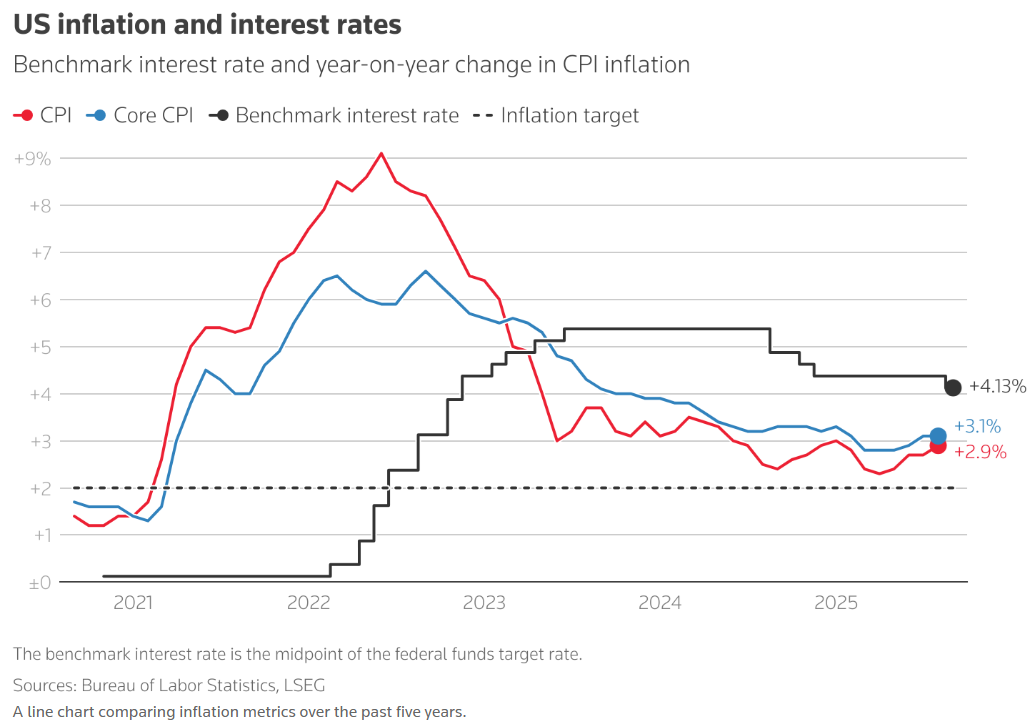
Source: Reuters
The U.S. Shifts Toward Easing
Last week, it cut its benchmark rate for the first time since December, citing a softer job market and easing inflation. Chair Jerome Powell indicated that more cuts are likely, with markets pricing in as much as 50 basis points of easing by December.
Other central banks have been less active. The Bank of England, the Bank of Japan, and the European Central Bank all kept rates steady, while Canada and Norway joined the Fed in trimming the costs of borrowing.
On Wall Street, the Fed’s move lifted sentiment. The Dow, S&P 500, and Nasdaq all posted gains, showing investors welcome cheaper money even if it signals concerns about economic strength.
China’s Steady Hand on Lending Rates
The People’s Bank of China is taking the opposite path. China’s central bank is expected to keep its benchmark lending rates steady next week, according to a Reuters survey. The one-year Loan Prime Rate, which influences most borrowing, should remain at 3.0%, while the five-year rate that guides mortgages is set to stay at 3.5%.
The decision follows the People’s Bank of China’s move to leave its seven-day reverse repo rate unchanged, signaling no rush to stimulate the economy despite remaining threats that we write about frequently. And even though July and August have weak data pointing to sluggish demand and a slower industry, Beijing seems content with stability for now.
Resilient exports and a stock market rebound have reduced pressure on policymakers. Barclays analysts say any fresh fiscal measures would likely be small, especially if the trade truce with Washington holds. Some expect a minor rate cut before year-end, but nothing more.
A Tale of Two Strategies
China’s approach contrasts sharply with Washington’s. For Beijing, the priority is avoiding excess stimulus and financial bubbles. As analysts point out, Chinese policymakers want to meet the 5% growth target but not overshoot it. That is why they see only a 10-basis-point cut this year.
The Fed faces a different problem. A cooling labor market has forced it to act sooner rather than later. By cutting rates now, it hopes to protect households and businesses from a sharper slowdown. The trade-off could be a weaker dollar and more volatility in capital flows.
This divergence may shift global investment patterns. A steady China could stabilize the yuan, while Fed easing might push money toward higher-yielding markets abroad.
Other Central Banks Hold Their Ground
Elsewhere, monetary authorities are taking different approaches. The Bank of England left its rates unchanged last week, with policymakers divided over how quickly to reduce government bond holdings. In Japan, the central bank also held steady, though two board members pushed for a small hike, signaling debate over future policy tightening.
In Canada, rates were cut to a three-year low of 2.5% in response to a weak labor market. Norway also lowered borrowing costs for the second time in three months, while Sweden and New Zealand are signaling caution but remain open to more easing if growth falters.
The European Central Bank has paused its cycle of cuts, with President Christine Lagarde saying the outlook is more balanced. Still, markets expect modest reductions.



.jpg)
